This post was last updated on August 19, 2021 by Preethi Sukumaran
We have been speaking on the Krya blog on the benefits of the Abhyanga. We recommend that everyone incorporates the Abhyanga into their weekly regimen to experience the dosha balancing benefits of the practice.
In our posts on Pitta dosha yesterday and the day before, we mentioned what a vital piece of the pitta balancing puzzle the Abhyanga is. When done regularly and with the right oils, the practice of Abhyanga helps trap excess heat throughout the body and in the eyes, and releases this heat through the sweda or the sweat along with the debris, dead cells and micro organisms that are also dislodged from the skin during the practice.
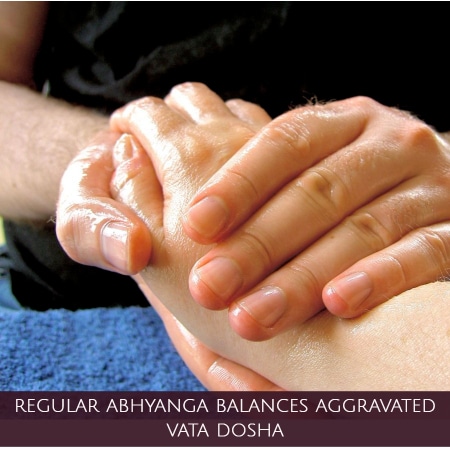
One of the most common reasons today for hair fall is the post partum loss of hair. Many of our consumers write to us in alarm having experienced a loss of volume of nearly 50% post pregnancy.
Western medical science tells us that a small amount of post partum hair loss is normal and inevitable. The rationale behind this is that oestrogen levels rise to extremely high levels during pregnancy. This drops to its normal level post partum – so the high oestrogen level contributes to thicker, fuller healthy hair growth during pregnancy. Post pregnancy as the oestrogen levels drop, there is supposed to be a temporary drop in hair growth which is supposed to adjust after a few months to the normal hair.

You may use the pointed use of many “supposeds” in the paragraph above. This is because the reality is quite different.
A modern pregnancy and how it deviates from many of the principles proposed by Ayurveda
We will explore this subject over the course of more posts, but the modern pregnancy and the diet followed is very contrarian to the principles proposed by Ayurveda. Ayurveda treats pregnancy as a special condition, (not an illness) and proposes that the pregnancy woman be treated very differently from what is normally done as regards to the diet, herbs given, and lifestyle.
Every month as the foetus grows, Ayurveda adds herbs that are appropriate to that stage of growth.
Here are some common contradictions in the Ayurvedic approach and a modern pregnancy. Once the pregnancy is established, Ayurveda‘s focus is on maintaining coolness and providing adequate amounts of nourishing, naturally sweet foods to sustain healthy growth. Therefore foods high in pitta like curd are considered strictly off limits. For the same reason, a pregnant woman is given copious amounts of tridoshic ghee and certain kinds of naturally cooling butters like navneetam to give the body a good amount of Sneha and maintain the right environment for the foetus to grow and thrive.
An increase in vata is not considered healthy in pregnant women. Also, as normal vata reducing measures like Abhyanga are contraindicated during pregnancy, aggravation of vata is controlled by strictly adhering to a simple, easy to digest diet and avoiding vata stimulating activities.
For example, Ayurveda would frown on air travel for pregnant women. It would consider this extremely vata stimulating. The main reason for taking this care is that normal vata reducing measures like Abhyanga, and in dire cases medicated procedures like vasti (medicated vata reducing enema) are not supposed to be done in Ayurveda.
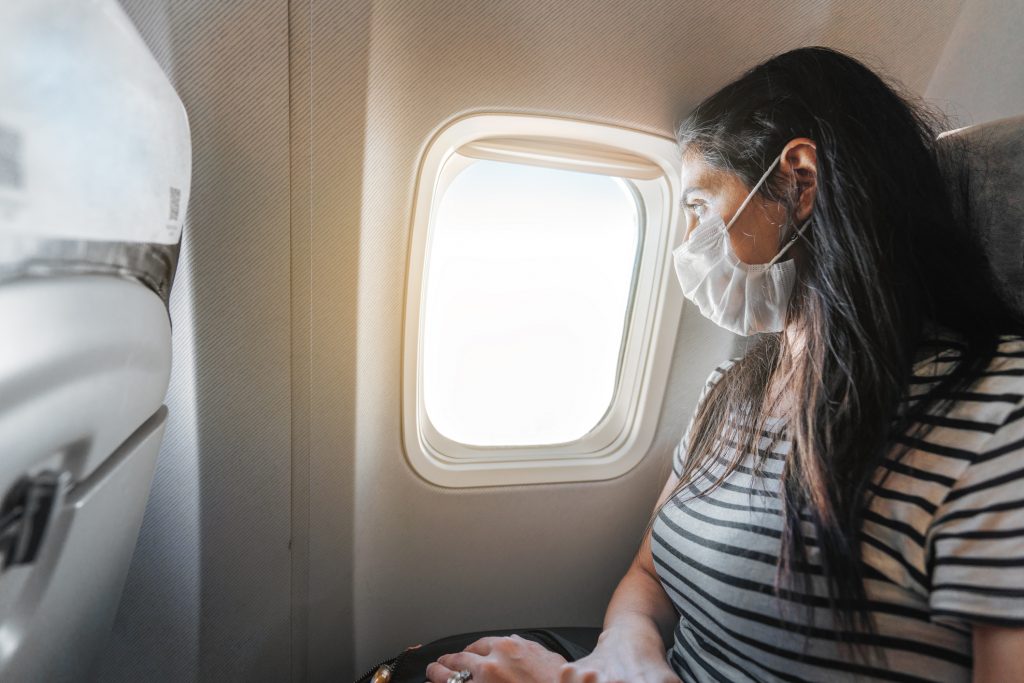
Vata is also carefully controlled to help the body prepare for the process of labour. For this reason, in Ayurveda, a pregnant woman is given carefully monitored medicated abhyangas towards the end of pregnancy in the 8th and 9th month. Medicated vastis (enemas) may also be added to clean out the body of any accumulated vata. We will see the reason for this emphasis on vata in the next section.
The effect of childbirth on vata dosha and Ayurvedic post partum care:
We have spoken at length about the differences between how Ayurveda treats the body and how Western science treats the body. This is evident even when we look at hair and skin disorders. As Ayurveda goes to the root cause of the disorder, it is able to be predictive and prescriptive and suggest holistic changes that tackle the problem much faster.
Nowhere is this more evident than how Ayurveda understands the action of vata dosha post child birth.
Soon after delivery, with the birth of the child and expulsion of placenta and other material in the womb, a large empty space forms in the womb. The nature of vata dosha which is made up of Vayu (wind) and Akash (space) is to rush in to fill this gap left behind by the newly born baby. This is why there is a strong Ayurvedic tradition of Sneha and Abhyanga for the post partum mother and child.
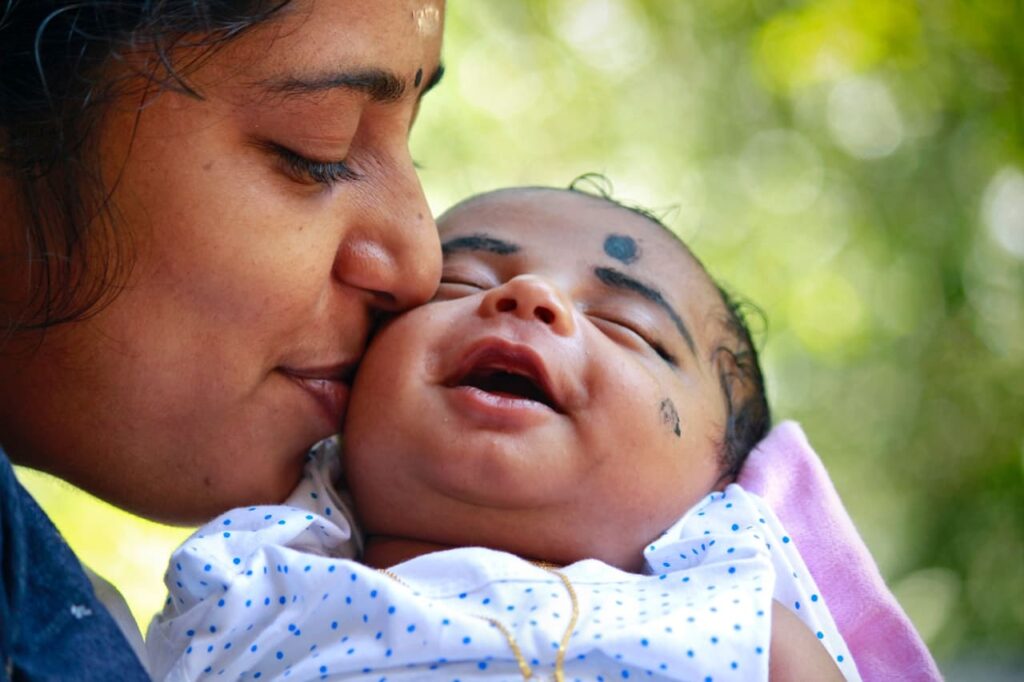
Traditional childcare practices also follow this wisdom – the stomach of the mother is tied tightly using cloth and a trained nurse’s assistance is sought to give both the mother and the baby a daily Abhyanga and bath. Typically vata reducing herbs are used in the oil and the bath water. For the baby this helps remove the exhaustion of child birth. For the mother, this deters vata form increasing and also helps relieve her strain and tiredness post delivery.
Apart from physically reducing the space for vata dosha to rush in by tying the stomach and oleating the body, the new mother is also given plenty of ghee, and sweet, easy to digest foods like old rice, Mung dal and a careful selection of vegetables. Vata increasing vegetables and lentils preparations are avoided for some time. The emphasis is on giving galactologue foods and foods that enable the mother to recover her strength quickly without impacting dosha balance.

The reality of modern post partum care
Conversation after conversation illustrates to us just how different the reality of having a baby in today’s world is. Most new mothers live in different cities from their parents and are usually working in high stress jobs almost right until their pregnancy. Maternity leave is usually around 3 months in many companies, after which these mothers rejoin work.
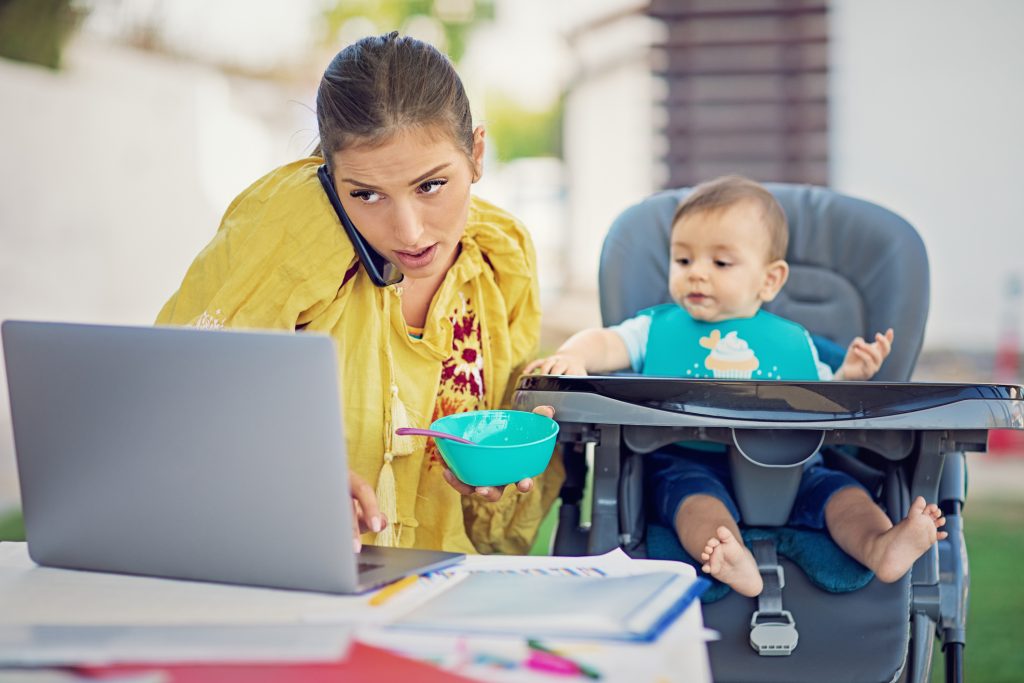
Also, very few mothers are now having normal deliveries. A C section ensures that the much needed oleation and Abhyanga cannot be done until the stitches heal, costing the mother a lot of valuable progress in reducing vata dosha. Plus the absence of good Ayurvedic doctors or trained nurses who can help with traditional baby care in cities means that the Ayurvedic practices I have outlined remain unknown.
Of course, over and above this, modern doctors see ghee as an anathema. It is considered unhealthy and cholesterol inducing, so even regular people do not consume it. It is not seen as important for the post partum mom or the pregnant women, thus again depriving her of a valuable dosha balancing food.
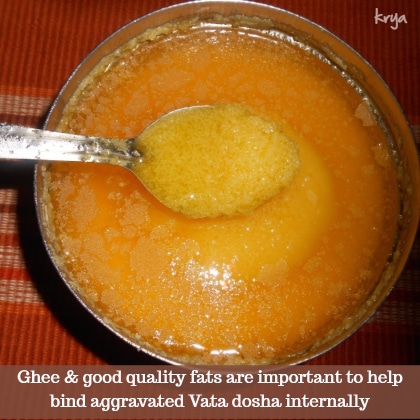
This means that when we at Krya get a call from moms who are losing hair at an alarming rate, we have already lost a valuable amount of time where we could have worked on the vata imbalance.
The connection between vata dosha imbalance and post partum hair fall:
We saw the shloka from the Charaka Samhita yesterday which talks about how aggravated pitta and vata dosha causes hairfall:
“ Tejoniladhau saha keshoboomim dagdhvashu kuryath khalitya narasya
Kinchitu dagdhva palithani kuryadhyareprabatham cha shiro roohanam”
“When high pitta combines with vata, it burns the hair from the roots very rapidly, causing baldness. If the pitta is not that high, it turns hair grey or fully white.”
So a post partum mom is already on a case of vata imbalance because of childbirth and the resultant gap in the womb. To this existing large vata imbalance, we can add an improper diet, lack of oleation, intake of food that is not conducive to her current state and we have the complete recipe for aggravated hairfall, hair thinning, premature greying and unhealthy hair.
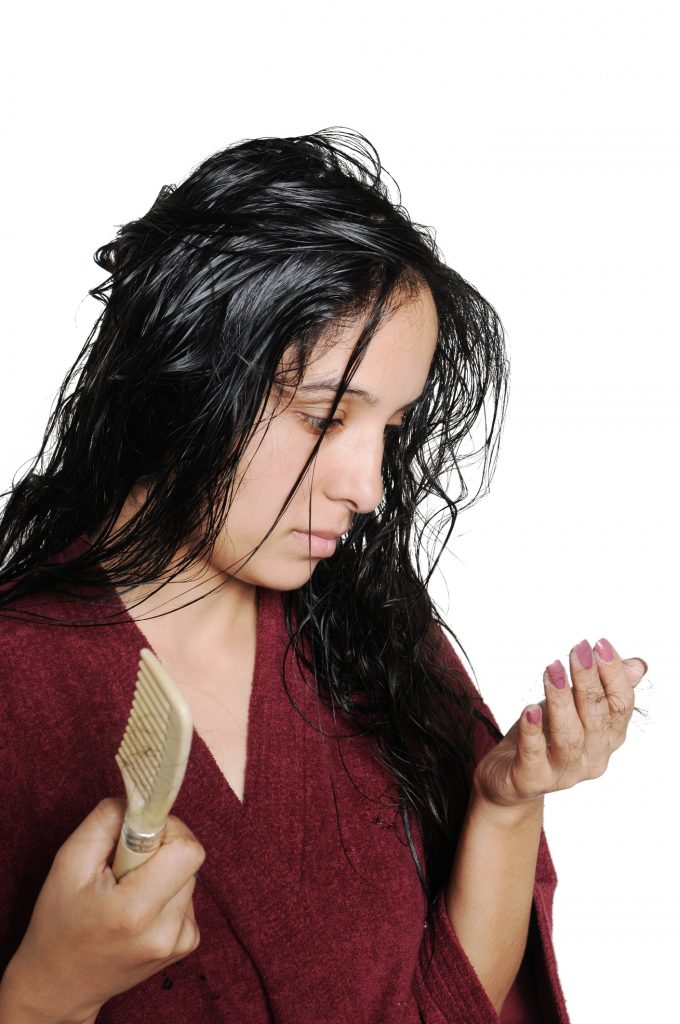
It is no wonder that all of our post partum Moms tell us that their entire body feels dry – their skin feels dry, rough and flaky. Their hair feels brittle, coarse and breaks easily when pulled or tugged or even when washed. They report seeing bunches of falling hair on their pillows when they wake up in the morning.
The 3 step Ayurvedic approach to post partum hair loss
We will spend a little more time tomorrow to elaborate further on this so you will have a handy reckoner of what to do to slow down your post partum hairfall. But here are the basic 3 Ayurvedic steps to establish your hair and health routine:
- Control the vata in your diet (and we have written several posts on the earlier)
- Reduce vata aggravating foods like bread, biscuits, ready to eat cereal, maida , fried food, aerated drinks
- Reduce vata aggravating vegetables in your diet – potatoes, cabbage, cauliflower, peas
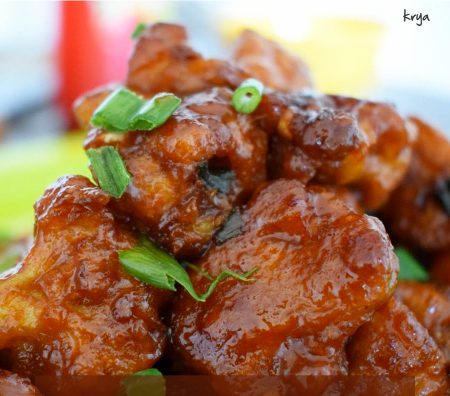
- Reduce vata aggravating lentils in your diet – channa, rajma, dried peas (anything that is hard, and takes a long time to cook)
- Reduce water depleting drinks like tea, coffee , cola and aerated drinks
- Add vata controlling , nourishing foods – ghee, old rice, split mung dal, native vegetables in season like squash, gourds, carrots, beets
- Change some parts of your lifestyle to bring down vata
- Eat on time every day
- Eat warm, freshly cooked food

- Focus on your food and eat in silence (talking while eating aggravates vata)
- Add a regular (twice a week) Abhyanga (head and body) to your routine which is done within the first hour of sunrise with vata controlling oils
- Cut down excessive travel
- Cut down vata aggravating practices like excessive cell phone and electronic screen usage
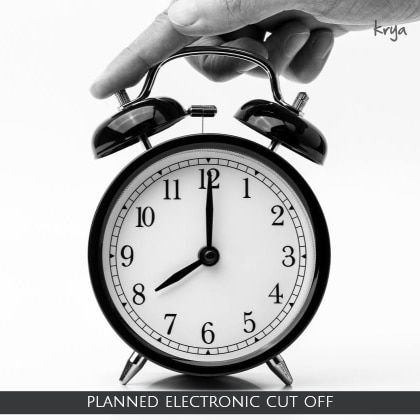
- Add the right products to your regimen (and we will give your some recommendations below)
Krya’s products that can help with post partum hair fall:
As the Abhyanga is the cornerstone to reducing vata which is essential to post partum hairfall, the Krya Abhyanga system can help you in balancing your doshas. The Krya Abhyanga system comprises of our Abhyanga skin oil and a specially formulated ubtan (we have different Ubtans for men and women). The Krya Abhyanga oil with Vacha and Ashwagandha has been specially formulated with Vata reducing herbs like Bala, Sunthi, Maricha, and Jeera to keep the body warm and trap excess vata.
You can explore these products here:
- Krya Abhyanga skin oil with Vacha and Ashwagandha (unisex)
- Krya women’s Ubtan with Lotus Leaf and Lodhra
- Krya Men’s Ubtan
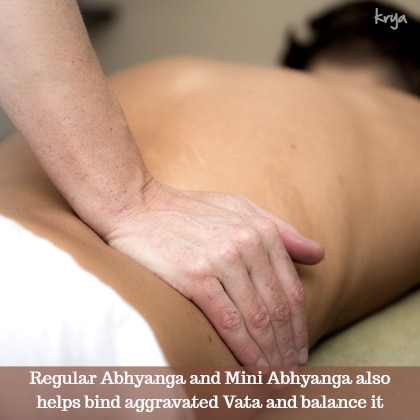
In addition to our Abhyanga products, we have 4 different hair systems depending on your hair type and hair issues.
- The Classic hair system helps pitta prone prakritis (straight or wavy hair that tends to get slightly oily – pitta dosha and therefore body heat is strong)
- The Conditioning hair system helps vata prone prakritis (wavy or curly hair that is typically quite dry, frizzy and experiences a lot of static – vata dosha therefore inherent dryness of skin and hair is strong)
- The Anti dandruff system helps if you have stubborn dandruff. We usually recommend treating the dandruff and then moving to a hair system that suits your prakriti
- The Damage repair hair system is if your hair has been severely chemically damaged
- The Intense Hair Oil along with other hair products we would suggest (if the hair fall is very strong due to other issues like severe medication, complicated pregnancy / delivery etc)
A holistic solution: the key to managing health
As we have been saying in the Krya blog, it is important to seek a holistic solution to your health. Skin and hair issues arise from a lack of balance in the body and are early warning signs. If we heed these early warning signs and take corrective action, we are able to prevent much bigger complications that could arise in the future.
We hope you enjoyed reading this post and also hope you were able to appreciate the difference in approach Krya follows when treating hair and skin problems. If you too are alarmed at your post partum hair fall and would like to consult us, do call us on 075500-89090 or write to us.
Remember, where there is health, there is beauty.




